Backwater sanitary valves
What is a backwater sanitary valve and how does it work?
Backwater sanitary valves (also known as “check valves” or “backwater valves”), are mechanical devices that are designed to allow the flow of water in one direction only – away from your home. Used on a sanitary sewer lateral, they can offer a decrease in risk of sewage backup if installed properly and maintained adequately.
A backwater sanitary valve is a type of check valve that is designed to only allow flow in one direction. Different backwater sanitary valves work in different ways, but in general, the type of device that is used in sanitary sewer scenarios works like this:
- The valve is normally in an open position: the “gate” (or “flap”) is open.
- When a backflow condition occurs, floats under the gate lift it up and start to block the backflow.
- If the backflow condition increases, the gate closes against a gasket and creates a seal which does not allow water to pass in the backwards direction.
- When the backflow condition ends, the gate falls back down due to gravity and returns to the open position to allow normal outflow of sewage from the home’s plumbing system.
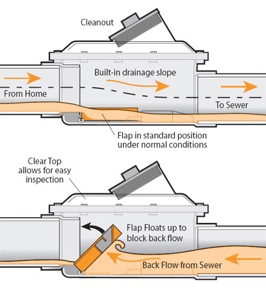
How a backwater sanitary valve works
(courtesy Mainline Backflow Products)
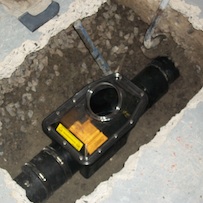
Typical backwater
sanitary valve installation
(courtesy Clean Water Works)
How are backwater sanitary valves installed?
There are a couple different types of backwater sanitary valves and they are installed in different ways. The most commonly used variety is called a Mainline Full-port Backwater Valve. It is installed by cutting a hole in the foundation inside the home above the main sewer line to expose it and allow for the installation of the device. There is another less common variety that can be installed somewhere on the sewer lateral outside the house, in the lawn for example.
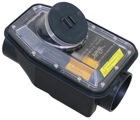
Mainline full-port
backwater sanitary valve
(courtesy of MainlineBackflow Products)
The location of installation needs to be downstream of all fixtures to offer full protection, in addition to any other manufacturer’s requirements that may exist. Installation of a backflow prevention device is not simple and this work is best undertaken by a licensed and qualified plumber, and it does require a Plumbing Permit from the City. Knowing if your foundation drain goes to the sanitary sewer or not is critical, and ideally, it should be redirected.
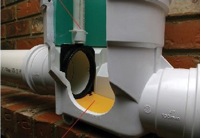
Normally-open Adapt-a-Valve
(courtesy Mainline Backflow Products)
Why do you need a plumbing permit to install a backwater sanitary valve?
Because there are a number of code requirements pertaining to backwater sanitary valves, a plumbing permit is required for installation. A plumbing inspection will allow for confirmation that the contractor has installed it correctly.
Does a backwater sanitary valve guarantee that a backup will not occur?
No. Unfortunately, while they can offer a lot of protection, there is no guarantee that a sewage backup will not occur because of a number of factors:
- Installation: The device needs to be installed correctly, including the location, orientation and position. If the plumber is not diligent in ensuring that the manufacturer’s specifications are followed, the device may not operate correctly. It is therefore worthwhile taking the time to understand the requirements of the device being installed and verify the contractor’s workmanship. Some issues are as follows:
- Location – The device must be located downstream of all sanitary fixtures yet upstream of any connection from the foundation drain (discussed further below).
- Orientation – Each device has directionality to it, in that it will only work if oriented correctly. Devices therefore usually have clearly illustrated arrows on them.
- Position – The device likely has a required slope to it that must be ensured for proper function.
- Slope – The devices typically have minimum slope requirements.
- Your foundation drainage complicates things. If your home’s foundation drainage is collected by a sump and then discharged to the lawn, a backwater sanitary valve has a good chance of being suitable.
If your foundation drain is connected to the sanitary sewer, the best scenario is to sever that connection. A connected foundation drain is problematic for two reasons:
- If the connection is downstream of the backwater sanitary valve, during a backup sewage will not backup into your home, but will backup into the drainage materials around your foundation, including the weeping tile.
- If the connection is upstream of the backwater sanitary valve, then in all likelihood, when the valve closes during a rainfall event the drainage of groundwater around your home may backup into your basement, since it cannot get away.
- Maintenance: Backwater sanitary valves are not maintenance-free items. They are mechanical devices in a dirty environment requiring regular maintenance and cleaning to best ensure they will operate properly during a backflow condition. Manufacturer’s recommendations for the type and frequency of maintenance should be followed.
- Knowledge:Take a moment now to consider a closed backwater sanitary valve. During a condition where the gate is closed, backwater cannot get into your home. This is great and what you want, but unfortunately, during this condition, the opposite effect is also true – sewage from your home cannot get out. Your home’s internal plumbing has limited storage capacity. If the gate is closed, and you happen to take a shower and run the laundry at the same time, this may rapidly fill up the space in your plumbing and if is too much for your plumbing to hold, it will start coming out in your own home, and the lowest available fixture – usually a floor drain or basement shower stall. Knowledge is key. Heavy rain or an intense snowmelt is not a good time to use a lot of water within your home.
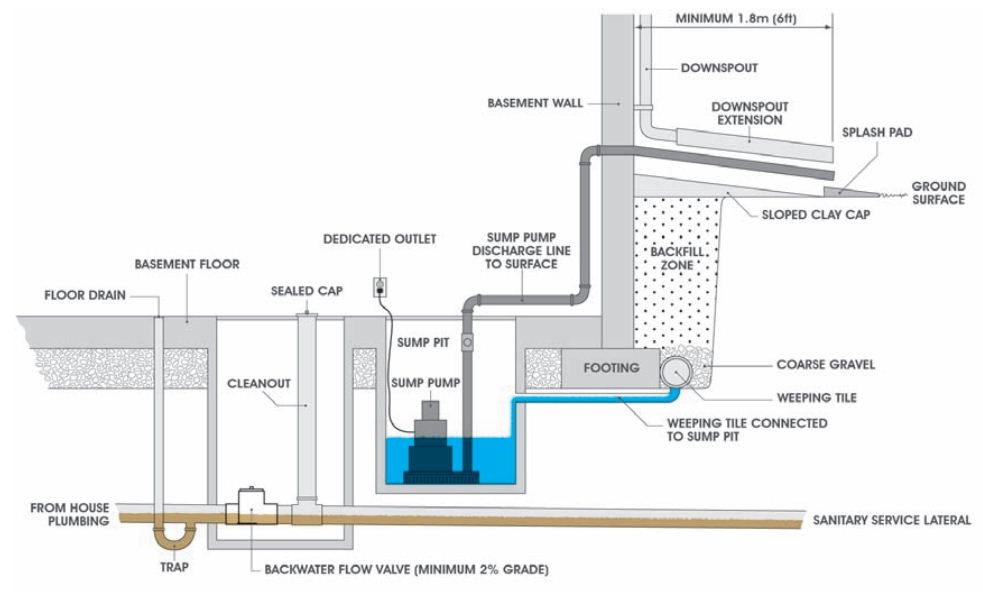
A backwater sanitary valve installation showing its correct position and disconnected weeping tile
(courtesy ICLR, 2009)
So, your best chance for making a backwater sanitary valve work for you is knowledge – to learn a bit about how it should be installed and verify your contractor is doing it right (to the best of your ability), ensure you have a plumbing permit, make sure your foundation drainage is not tied in to the sanitary lateral, learn how to maintain it and learn the do’s and don’ts of water usage when you have one installed.
Additional Resources
- Handbook on backwater valves - by the Institute for Catastrophic Loss Reduction
- How to Reduce the Risk of Basement Flooding – a YouTube video posted by the Insurance Bureau of Canada
- Mainline BackFlow Products – as of this writing, Mainline is the only producer of backwater sanitary valves that meet Ontario Building Code
